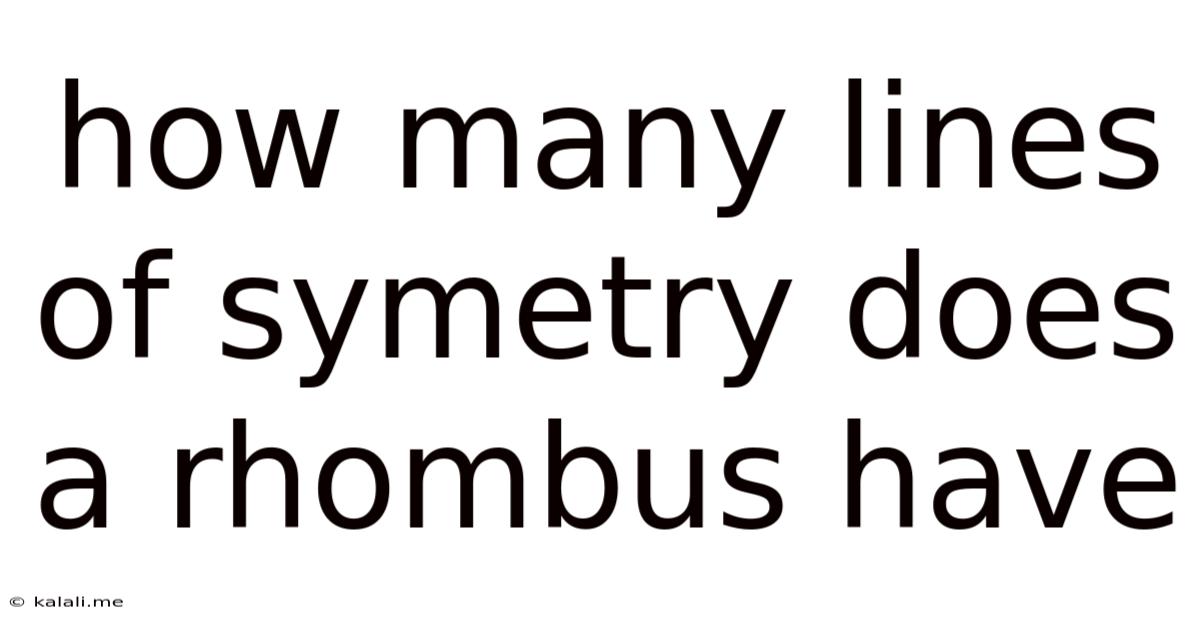How Many Lines Of Symetry Does A Rhombus Have
Kalali
Jun 11, 2025 · 2 min read

Table of Contents
How Many Lines of Symmetry Does a Rhombus Have? A Comprehensive Guide
A rhombus, a quadrilateral with all sides equal in length, often sparks curiosity about its geometric properties, particularly its lines of symmetry. Understanding lines of symmetry is crucial in geometry and can help visualize the shape's inherent balance and reflective properties. This article will delve into the intricacies of a rhombus and definitively answer the question: how many lines of symmetry does a rhombus have? We'll explore the different types of rhombuses and their unique characteristics.
Understanding Lines of Symmetry
Before we tackle the rhombus specifically, let's clarify what a line of symmetry is. A line of symmetry is a line that divides a shape into two identical halves, mirroring each other perfectly. If you were to fold the shape along the line of symmetry, both halves would overlap exactly. This concept is fundamental in understanding the geometrical properties of various shapes.
Exploring the Rhombus
A rhombus is a parallelogram with all four sides being congruent. This means all sides are of equal length. However, this doesn't automatically define the number of lines of symmetry. The angles of the rhombus play a significant role in determining its symmetry.
Types of Rhombuses and Their Symmetry
There are two main types of rhombuses relevant to our discussion of lines of symmetry:
-
A Square: A square is a special type of rhombus where all four angles are right angles (90 degrees). A square possesses four lines of symmetry: two lines connecting opposite corners (diagonal lines) and two lines connecting the midpoints of opposite sides (vertical and horizontal lines).
-
A Non-Square Rhombus: This is a rhombus where not all angles are equal. In this case, it only has two lines of symmetry, both running through opposite corners (the diagonals).
Why only two lines of symmetry for a non-square rhombus?
The diagonals of a rhombus bisect each other at right angles. Crucially, these diagonals also bisect the angles of the rhombus. However, only in a square (a special case of a rhombus) are the angles all 90 degrees, leading to four lines of symmetry. In a non-square rhombus, the angles are not equal, preventing the existence of lines of symmetry through the midpoints of opposite sides.
In Conclusion: The Answer
Therefore, the answer to the question, "How many lines of symmetry does a rhombus have?" depends on the type of rhombus.
- A square (a special type of rhombus): 4 lines of symmetry.
- A non-square rhombus: 2 lines of symmetry.
This understanding of symmetry is crucial not just in geometry, but also in various fields like art, design, and even computer graphics, highlighting the practical application of this fundamental geometric concept. Understanding the distinct properties of different types of rhombuses helps appreciate the richness and diversity within this seemingly simple geometric shape.
Latest Posts
Latest Posts
-
Mi Familia Fuera La M S Grande Correct Incorrect
Jul 01, 2025
-
How Much Is 20 Pounds Of Pennies Worth
Jul 01, 2025
-
How Much Does A Gallon Oil Weigh
Jul 01, 2025
-
How Many Crackers In A Sleeve Of Saltines
Jul 01, 2025
-
How Many Years Are In 48 Months
Jul 01, 2025
Related Post
Thank you for visiting our website which covers about How Many Lines Of Symetry Does A Rhombus Have . We hope the information provided has been useful to you. Feel free to contact us if you have any questions or need further assistance. See you next time and don't miss to bookmark.